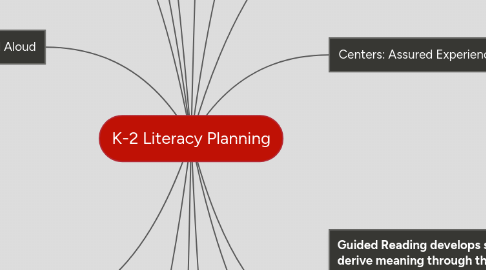
1. Sight Words
1.1. Each grade level will have a required set of words to teach to all students
1.1.1. Goal is mastery by the end of the grade level
1.2. Benchmark= Students have control of these words by th eend of the grade level
1.2.1. Control = reading and writing a word in and out of context
1.2.2. Studenst will be assessed 3 x a year out of context as part of their literacy profile
2. Vocabulary Development
2.1. Teachers will be expecte dto introduce a minimum of 250 tier 2 words per year
2.1.1. each grade level will have 100 mandatory words and150 from their own discretion
2.1.2. Words need to be visually accessible to all studnets from their desk all day long
3. Writing
3.1. Writers workshop model
3.1.1. Mini lesson
3.1.2. work time
3.1.3. conferences
3.1.4. sharing
3.2. Process writing vs. Flash Writing/On-Demand Writing
3.3. Must use ALL Lucy units for grade level as indicated by the Hilton Modules
3.4. Use rubric throughout the year - not just at the two required moments when it is submitted to the District
4. Read Aloud
4.1. Should happen a minimum of 1x per day
4.1.1. Should include fiction and non fiction
4.1.2. complex texts
4.1.3. Use for all subject areas
4.1.4. Genre study
4.1.5. May consist of the required 3 close reads per month
5. Required Resources
5.1. Guided Reading by: Fountas and Pinnell
5.2. Next Steps in Guided Reading by: Jan Richardson
5.3. The Continuum of Literacy Learning by: Fountas and PInnell
5.4. Words Their Way
5.5. Units of Study by: Lucy Calkins
5.6. Prompting Guide by Fountas and Pinnell
5.7. F&P LLI Alphabet Linking Chart AND Blend Chart
5.7.1. In every child's writing folder
5.7.2. Prominently posted in every classroom
6. Sample Literacy Block Schedule
7. Whole Group Daily Mini Lesson
7.1. Close Reading
7.2. Must be on grade level or above text associated with standard and module
7.3. May consist of the required 3 close reads per month
7.4. Balance explicit direct instruction with module standards
8. The First Six Weeks: Routines
8.1. First 20-30 school days should be spent:
8.1.1. Explicitly instructing students on expected behaviors during all components of the literacy block
8.1.2. Reference F&P Guided Reading (chapter 5) or Jan Richardson's Next Steps in Guided Reading (chapter 1)
9. Centers: Assured Experiences
9.1. Listening center 1x per week minimum
9.1.1. Focus: Complex Texts
9.2. Independent reading at the students' independent level
9.2.1. 15-20 minutes per day
9.3. Read Around the room (All kindergarten and 1st grade at DRA levels<12)
9.3.1. 1-2x per week
9.4. Extension writing from guided reading
9.4.1. 2-3x per week
9.5. Letter and Word work
9.5.1. 4-5x per week
9.6. All centers must be driving the students to meet benchmark expectations
10. Guided Reading develops strategic readers who are fluent, accurate and derive meaning through the text alongside peers with similar needs. Within this context, students are explicitly taught developmentally appropriate skills and strategies in conjunction with the District ELA Modules.
10.1. Planning
10.1.1. Framework: use either Jan Richardson's Planning sheet or the Reading Recovery planning page
10.1.1.1. If you would like to use a different framework, see your principal and show that you are getting every child to benchmark and helping those who struggle to make accelerated progress
10.2. Frequency
10.2.1. On benchmark= minimum 3x a week
10.2.2. Below grade level = minimum 5x a week
10.3. Purposeful Running Records
10.3.1. Minimum of 1 per week per child
10.4. Group Size
10.4.1. Below grade level 1-3 students
10.4.2. On grade level 4-6 students
11. Assessment/ Data Collection
11.1. Spelling Inventory
11.2. Writing Rubrics
11.3. Running Records
11.3.1. How often?

